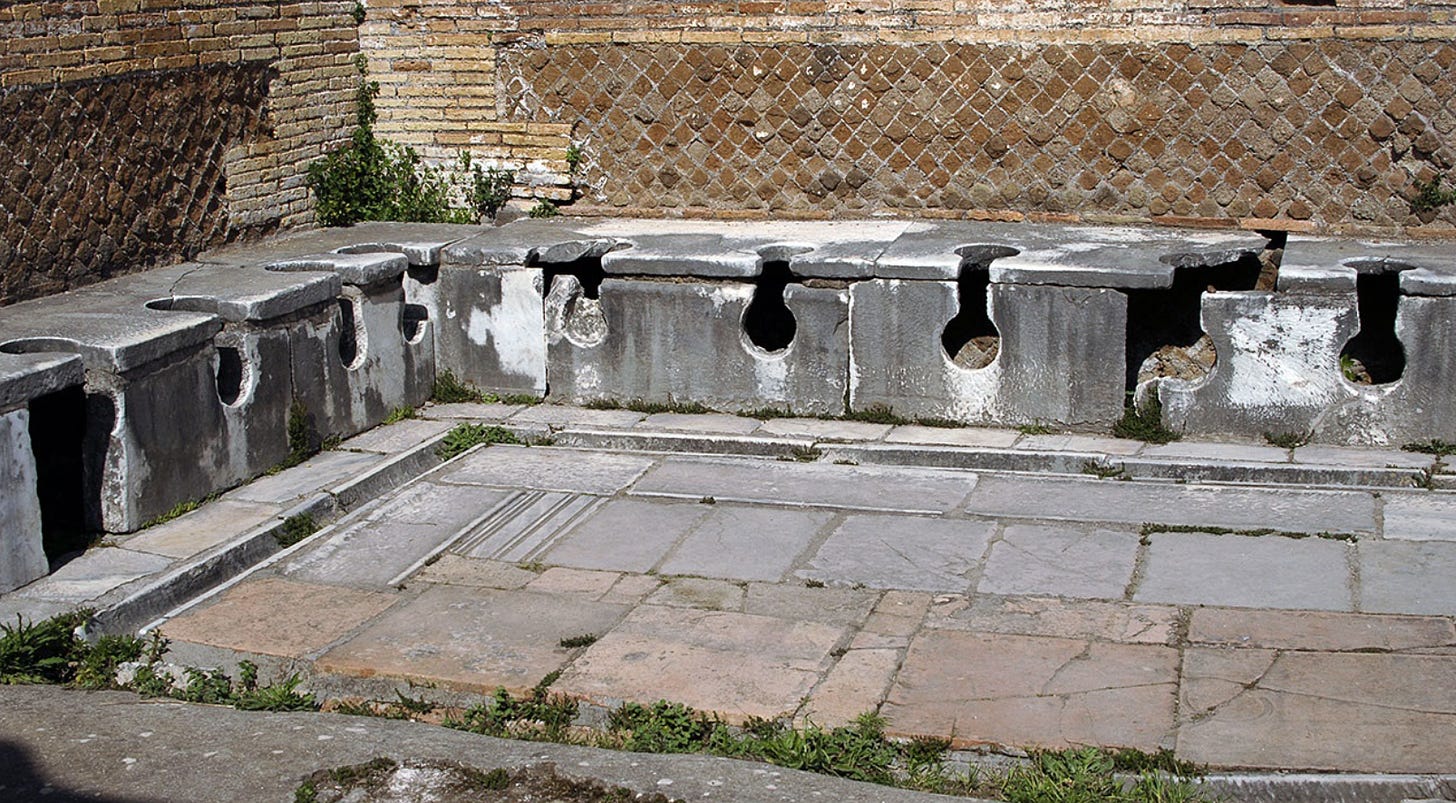This is the perfect moment to let you in on something—I originally thought I could cover the entire history of the toilet in a single episode. But as I started digging (not literally, thankfully), I realized that the sheer wealth of information, bizarre innovations, and jaw-dropping sanitation practices deserved more than just one episode. So, congratulations, dear listener—you’re getting a two-parter. And trust me, you’ll want to stick around for all of it.
Think about it: We use toilets daily, yet we rarely stop to consider how we got here. We take for granted the fact that we can flush and walk away without a second thought instead of tossing the contents of a chamber pot out a window and hoping for the best. The road to modern plumbing was long, messy, and, at times, horrifyingly unsanitary.
In this first episode, we’re covering the earliest attempts at waste management, from the caveman era (where “going” was as simple as finding a good bush) to the impressive sewer systems of ancient Rome, where bathroom breaks were more social events than private retreats. We’ll explore the accidental genius of early sanitation methods, the catastrophic failures of some of history’s worst bathroom designs, and the infamous communal sponge on a stick that the Romans thought was a good idea.
But this is just the beginning. Because after Rome’s glorious indoor plumbing came crashing down with the empire's fall, things got significantly worse before they got better. In part two, we’ll dive into the absolute nightmare of medieval sanitation, the filth-ridden cities of the Renaissance, and how humans finally crawled their way out of the sewage-filled streets and into the comfort of indoor plumbing.
So, sit back, get comfortable, and be grateful for whatever bathroom situation you have today—because, as you’re about to find out, history’s toilets were much worse.
Part One Introduction: The Unsung Hero of Civilization
Toilets are something we rarely think about—until they stop working. A clogged toilet can feel like a crisis, a broken one an outright disaster. It’s the kind of modern emergency that forces you into desperate calculations: do you have a plunger? Can it wait? Is there another bathroom nearby? And if all else fails, do you have a neighbor who won’t ask questions?
But now imagine a world where a broken toilet isn’t the problem—because there are no toilets at all. No flushing, no plumbing, no doors to hide behind—just the raw, unfiltered reality of human waste disposal. This is not a dystopian nightmare; this was daily life for most of human history. The fact that we can now sit comfortably in a well-lit, climate-controlled bathroom and push a button to make everything disappear? Our ancestors would probably weep if they knew about such an enormous luxury.
The story of the toilet is not just about convenience—it’s about survival. It's about public health, urban planning, and social class. It’s about power, privilege, and some truly horrifying smells. The evolution of sanitation has determined how civilizations have risen and fallen, how diseases have spread or been contained, and how different cultures have viewed the most universal human experience: the need to go.
From prehistoric humans squatting in the bushes to Roman public latrines, from medieval chamber pots to the avocado-green bathrooms of the 1970s, every era has found its own way to deal with this inescapable biological function. Some methods were ingenious (early sewer systems!), some were horrific (medieval open sewage ditches!), and some were downright bizarre (looking at you, ancient Romans, with your communal butt sponge).
So, let’s embark on a journey—one filled with pit latrines, chamber pots, and questionable hygiene choices—as we flush out the full history of the toilet. Prepare yourself for some surprising innovations, stomach-churning details, and moments of pure gratitude that you live in the age of indoor plumbing.
The Caveman Era: Open-Air Bathrooms and Natural Sanitation

Before humans discovered fire, invented the wheel, or figured out how to domesticate animals, they had already mastered one fundamental skill—pooping. But in those early days, the art of waste disposal was, to put it bluntly, a complete free-for-all. There were no designated bathrooms, no privacy, and absolutely no dignity. If you needed to go, you simply squatted where you stood, did your business, and hoped no one was watching.
Because early humans were nomadic, moving constantly in search of food, their waste never really became a major problem. This accidental "scattering sanitation" method worked out pretty well—nature took care of the mess before anyone had time to notice. Rain washed it away, the wind dried it up, and various insects and scavengers ensured nothing went to waste (an eco-friendly and horrifying concept).
But the moment humans started staying in one place for longer, things got messy. At first, people probably didn’t think much about where they were going, and stepping into someone else’s pile became an all-too-common and deeply unpleasant part of daily life. This was the point where the first great sanitation innovation likely occurred: humans started choosing specific areas away from their sleeping quarters as their “bathrooms.” Congratulations, early humans—you just invented the designated pooping zone.
Of course, this was still far from a structured sanitation system. There were no waste management services, weekly pick-ups, or public health regulations. If the area got too disgusting, the solution was simple—move somewhere else. But new strategies were needed for those who weren’t keen on abandoning their hard-earned shelter just because the ground had become a biohazard. Some groups may have tried covering waste with dirt or leaves to control the smell, while others might have burned it—an idea that would be rediscovered thousands of years later when civilizations realized that fire was good for more than just roasting mammoth steaks.
There was no official cleanup crew—nature did the job, and people were more than happy to let it. But the seeds of sanitation had been planted. The next step? Figuring out how to deal with waste when simply walking away from it was no longer an option. Spoiler alert: this took thousands of years, many failed attempts, and several experiments involving communal sponge sticks.
The Agricultural Revolution: Pit Latrines and the Beginning of Structured Waste Disposal
For thousands of years, the world was basically a free-range toilet. People could squat wherever they pleased, wander off, and never have to deal with their personal deposits again. In a way, it was a beautiful system—waste was nature’s problem, not a human one. But then, humans got clever. Or, depending on how you look at it, made life much harder for themselves. Farming changed everything.
With agriculture came permanent settlements, which meant that people were sticking around in one place for the first time long enough to realize that stepping in yesterday’s leftovers was becoming a serious problem. Suddenly, the great freedom of "going" wherever nature called was becoming a logistical nightmare. What happens when your waste doesn’t just disappear with the next rainstorm, and things start to really pile up? And more importantly, how do you ensure your dinner isn’t just a few missteps away from a serious health hazard?
Enter the pit latrine—humanity’s first attempt at organized pooping. The concept was revolutionary in its simplicity: dig a hole, do your business, and cover it up with dirt or leaves to keep the smell and disease at bay. It was nature’s version of the flush button—much slower, less effective, and significantly more shoveling involved.
Some early settlements, like Skara Brae in Scotland around 3200 BCE, took things a step further. Instead of just squatting over a pit and calling it a day, they built small drainage channels to carry waste away from their homes. This was a major leap forward in sanitation—an early attempt at plumbing without the luxury of porcelain, pipes, or a dedicated maintenance crew. American Heritage notes that civilizations slowly realized the importance of keeping waste away from living spaces, something modern cities still struggle with today when sewer lines back up.
Let’s be clear—these early attempts at sanitation were still far from perfect. Pit latrines smelled terrible, even if you covered them with dirt because the aroma of human civilization in full bloom was hard to ignore. They were also a contamination disaster waiting to happen. Congratulations if placed too close to a water source—you just invented the first case of mass dysentery in an era where vaccinations did not yet exist. And these latrines collapsed often, meaning that occasionally, someone’s worst nightmare would come true: the ground beneath them would give way at the worst possible moment. One second, they’d be squatting peacefully, contemplating the meaning of life (or at least what was for dinner), and the next, they’d be plunging straight into a pit of human waste. There was no graceful recovery from such an event—no amount of scrubbing in a nearby river, no pile of fresh leaves, no amount of pretending it didn’t happen could undo the horror of sinking waist-deep into a communal cesspool. The smell alone would cling to a person for days, and socially? Let’s just say you’d be lucky if your neighbors ever made eye contact with you.
There’s a long, grim tradition of waste management being assigned to the people with the least social power. No one in their right mind wanted to be responsible for maintaining these pits, so the job inevitably fell to those with no choice—enslaved people, the poor, or the lowest-ranking laborers in society. These individuals weren’t just tasked with digging new pits and emptying and relocating old ones when the stench became unbearable or when a latrine threatened to overflow. Imagine spending your days hauling buckets of waste out of a hole while the rest of the town carried on with their lives, blissfully unaware of just how much they owed their relative cleanliness to your thankless work.
Wealthier families, of course, sought to distance themselves from the whole disgusting process. If you had money, you weren’t about to subject yourself to the sights and smells of a communal latrine, so private waste disposal became a sign of status. Aristocrats and elites often had their own latrines—sometimes built in walled-off areas or small outhouse-like structures tucked away in the garden. These private spaces offered a little more dignity, though the waste still had to go somewhere, and that somewhere usually meant an unfortunate servant was responsible for either covering or emptying it.
For most of the population, though, the reality was far less refined. If you were poor, you shared a communal pit with the rest of your village or neighborhood, meaning every trip to the latrine was a deeply unpleasant social experience. There was no privacy, and the smell was overwhelming, especially in warmer climates. Worse still, if the pit was located too close to living areas, it wasn’t just an olfactory nuisance—it was a genuine health hazard, with waste leaching into the soil and contaminating drinking water.
And then there were the truly unlucky souls—the ones assigned to dig new latrines when the old ones became unusable. These were the people standing knee-deep in the filth of civilization, armed with only a shovel and the knowledge that, no matter how deep they dug, this job would never be finished. Even in societies where sanitation practices were evolving, there was no escaping the reality that somebody, somewhere, had to deal with the inevitable results of human digestion.
Despite all of its flaws, the pit latrine marked a huge leap in human civilization. It was a step toward recognizing that sanitation actually mattered, and it set the foundation for future advancements in waste disposal.
The Indus Valley Civilization: Early Plumbing and the World’s First Flush Toilets
By 2800 BCE, the Indus Valley Civilization (modern-day Pakistan and India) had done something truly impressive: they figured out how to stop living in their own filth. While much of the ancient world was still winging it with open pits and creative squatting techniques, cities like Mohenjo-Daro were taking sanitation to a level that some modern cities still struggle to maintain.
Instead of the standard hole-in-the-ground approach, private homes in Mohenjo-Daro were equipped with brick-built toilets that connected to covered sewage drains. Yes, you read that correctly—actual indoor toilets in private homes nearly 5,000 years ago. Unlike the pit latrines that required constant digging and the occasional horrifying collapse, these toilets used a manual flush system. A small amount of water—poured by hand—helped wash waste into an underground drainage system that carried it out of the city. No chamber pots, bucket-dumping, or stepping outside in the dead of night to avoid a full-house situation. This was cutting-edge stuff.
But here’s where it gets even more fascinating. Unlike many later civilizations that saw sanitation as a luxury for the elite, the Indus Valley prioritized public hygiene for nearly everyone. This wasn’t just about keeping the wealthy comfortable while the poor suffered in filth. Most homes, not just palaces or upper-class dwellings, had access to the drainage system, proving that early city planners understood something that took much of the rest of the world centuries to figure out: keeping waste away from people is a good idea.
Of course, having an advanced sewer system was one thing—maintaining it was another. Waste doesn’t just disappear (despite what modern plumbing would have us believe), and someone had to keep things running smoothly. Enter the souls responsible for clearing blockages and ensuring waste flowed away from the city. These were likely lower-class workers whose job was as thankless as it was revolting. If a clog occurred, someone had to go in and clear it, armed with nothing but primitive tools, sheer willpower, and possibly a complete loss of their sense of smell.
It was dangerous, dirty, and incredibly unpleasant work, but absolutely necessary. Without them, the entire system would have backed up, turning the marvel of Indus Valley sanitation into a citywide disaster. Imagine the smell of thousands of homes with blocked sewage drains on a hot summer day—suddenly, digging a pit latrine and covering it with dirt doesn’t sound so bad.
Despite the grim maintenance reality, the Indus Valley’s early sanitation system was a triumph. It was thousands of years ahead of its time, and the rest of the world—Romans included—would take centuries to catch up. Unfortunately, as advanced as their sewage system was, it couldn’t save the civilization itself. By 1900 BCE, the cities were in decline, and eventually, their incredible plumbing system was lost to history. It would take a long time before humans would once again embrace the idea that flushing waste away is better than letting it pile up where you live.
Ancient Rome: Public Toilets, Sewer Systems, and the Infamous Sponge Stick
By 500 BCE, Rome had taken sanitation to an entirely new level, turning what had been a messy, smelly necessity into a feat of engineering. While other civilizations still relied on pits and rudimentary drainage, the Romans were busy designing one of the earliest large-scale sewer systems, the Cloaca Maxima, which helped carry waste away from the city and into the nearby Tiber River. It wasn’t exactly a perfect system—dumping sewage directly into the river wasn’t great for water quality—but it was a major improvement compared to the alternative of streets running with filth.
Romans didn’t just build sewers; they also embraced public toilets on a scale never seen before. For most citizens, bathroom time was not a private affair but a communal experience. Public latrines were designed for efficiency, not modesty. Picture long, beautifully carved marble or stone benches lined up in neat rows, each with a series of round holes cut into them. There were no dividers, no doors, and certainly no personal space. Sitting shoulder to shoulder, people would do their business while chatting about the latest gossip, politics, or gladiator matches. It was part restroom, social club, and awkward team-building exercise.
For wealthier Romans, things were a little more comfortable. Many aristocrats had private toilets in their homes, though they weren’t exactly independent plumbing systems. Even these so-called private latrines emptied into the same shared drainage network as the public facilities. This meant that, depending on your location and the general state of maintenance, an unpleasant surprise might occasionally travel back up the pipes. There’s evidence that some homes kept pet ferrets to chase out sewer-dwelling creatures like rats and snakes that sometimes made the journey up the waste channels. Indoor plumbing had its perks, but it also came with its own terrifying hazards.
Perhaps the most unsettling part of the Roman bathroom experience wasn’t the lack of privacy but the method of wiping. Instead of toilet paper, Romans used a communal sponge on a stick, known as a tersorium. The concept was simple: after finishing up, a person would take the sponge, give themselves a thorough cleaning, and then rinse it in a bucket of vinegar water before leaving it for the next lucky user. It was the ancient world’s answer to a reusable eco-friendly product but also a bacteria-infested nightmare. The idea of sharing a sponge with countless strangers, no matter how much vinegar water was involved, is enough to make germaphobes faint. And yet, this system remained in use for centuries, proving that the Romans were both brilliant engineers and, at times, questionably committed to hygiene.
Despite the quirks and questionable sanitation practices, Roman public toilets represented a major step forward in urban infrastructure. They kept streets cleaner than in many later European cities, where chamber pots were emptied out of windows onto unsuspecting passersby. The Romans may not have had privacy, but at least they weren’t dodging airborne waste every time they stepped outside.
But what happened when the mighty Roman Empire collapsed and left their sewer systems to crumble? Well, let’s just say that the Dark Ages were not known for their commitment to hygiene. With Rome’s well-planned latrines gone, sanitation took a long, smelly detour into chaos. Waste disposal went from a system of underground drainage to an "out-the-window-and-hope-for-the-best" approach. The medieval world brought us open sewage ditches, chamber pots, and some of the worst-smelling cities in history.
In the next episode, we’ll dive into medieval sanitation's messy, unfiltered reality—a time when waste piled up faster than solutions, and public health was more of an afterthought than a priority. We’ll explore why castles had toilets that emptied straight down the walls, how entire streets doubled as open sewers, and what people did before toilet paper (spoiler: it involved whatever was lying around). If you thought sharing a communal sponge in Rome was bad, just wait until you hear about what came next.
Does this toilet history make you oh so happy that you are well-informed? Now accepting love via donations at buymeacoffee.com/marypoopins!
Remember, for anything medical—potty or otherwise—consult your licensed doctor! 💩☕
Sources
Wikipedia: https://en.wikipedia.org/wiki/Toilet
American Heritage: https://www.americanheritage.com/bathroom-epic
Stone City: https://www.stonecity.com/blog/evolution-of-the-american-bathroom/














Share this post